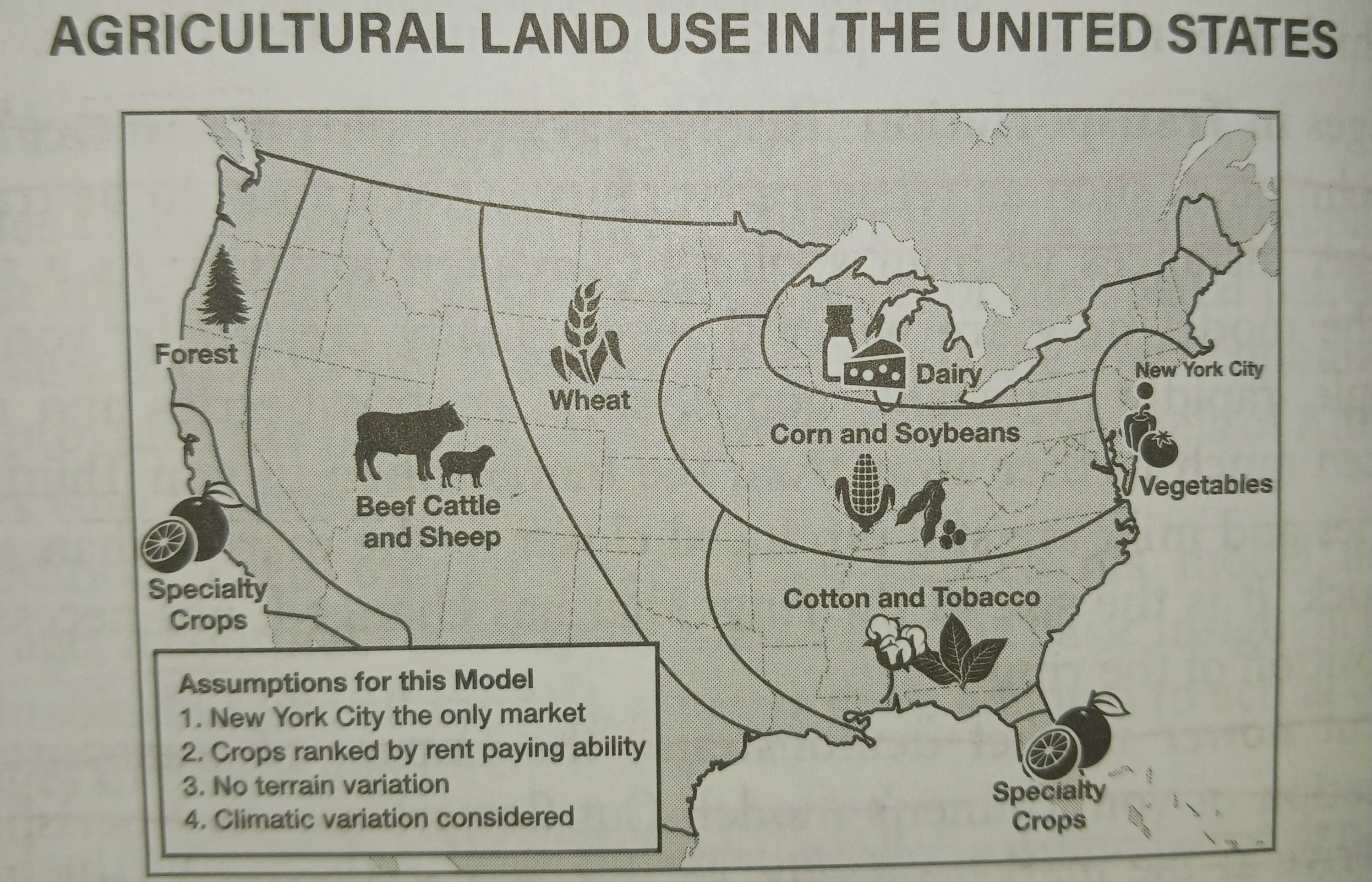Unit 5 APHG Unit review
1/101
Earn XP
Name | Mastery | Learn | Test | Matching | Spaced |
|---|
No study sessions yet.
102 Terms
Agribusiness
A highly mechanized and large-scale farming system owned by corporations.
Agriculture
The cultivation of domesticated` crops and animals for human use.
Aquaculture
The cultivation of aquatic organisms, especially for food production.
Bid-Rent Theory
Land/property/rental unit costs increase the closer one gets to a city's central business district.
Founder: William Alonso
Bid-rent theory pros and cons
Pros:
Bid rent theory is easy to grasp as it reflects common observations in real estate and urban landscapes. For example, we can easily see how prices increase closer to the city center due to higher demand for space.
It provides a framework for understanding why certain types of activities tend to cluster in specific areas of a city, such as commercial activities in the central business district (CBD) and residential areas further out.
Cons:
The theory doesn't account for modern developments like online shopping, which can disrupt traditional retail patterns. This means it might not accurately predict future urban land use changes.
It assumes a specific urban structure with distinct zones like CBD, industrial, and residential areas. However, not all cities fit this model, like those with multiple CBDs or decentralized development patterns. In such cases, the bid rent theory may not be as relevant or useful.
Biodiversity
The wide variety of life on Earth, specifically all species in a region or ecosystem.
Biotechnology
Application of technological processes using biological systems to create or modify products.
Ex. GMO’s
Carrying Capacity
The maximum number of people or organisms a region can support without environmental degradation.
Columbian Exchange
Transfer of plants, animals, culture, technology, diseases, and ideas between the Americas, West Africa, and the Old World.

pros and cons of the Columbian exchange
Pros:
1. Cultural Exchange: The Columbian Exchange facilitated the exchange of ideas, languages, religions, and cultural practices between the Eastern and Western Hemispheres. This led to a rich cultural blend, contributing to the diversity of global cultures.
2. Biological Diversity: The exchange introduced new crops, animals, and plants to different parts of the world, enriching agricultural practices and diets. For example, crops like maize, potatoes, and tomatoes from the Americas became staple foods in various regions.
3. Technological Diffusion: The exchange also spread technologies and innovations, such as new farming techniques and navigation methods, which improved living standards and expanded trade routes.
Cons:
1. Disease Spread: The Columbian Exchange resulted in the inadvertent transmission of diseases between continents, leading to devastating epidemics among indigenous populations. Diseases like smallpox, measles, and influenza, to which Native Americans had no immunity, caused widespread death and population decline.
2. Ecological Disruption: Introduction of non-native species to new ecosystems disrupted local flora and fauna, leading to ecological imbalances and biodiversity loss. For instance, invasive species like rats and weeds caused harm to native species and ecosystems.
3. Social Disruption: The exchange also brought about social upheaval and conflicts as European powers colonized and exploited indigenous populations for labor and resources, leading to displacement, enslavement, and cultural suppression of indigenous peoples.
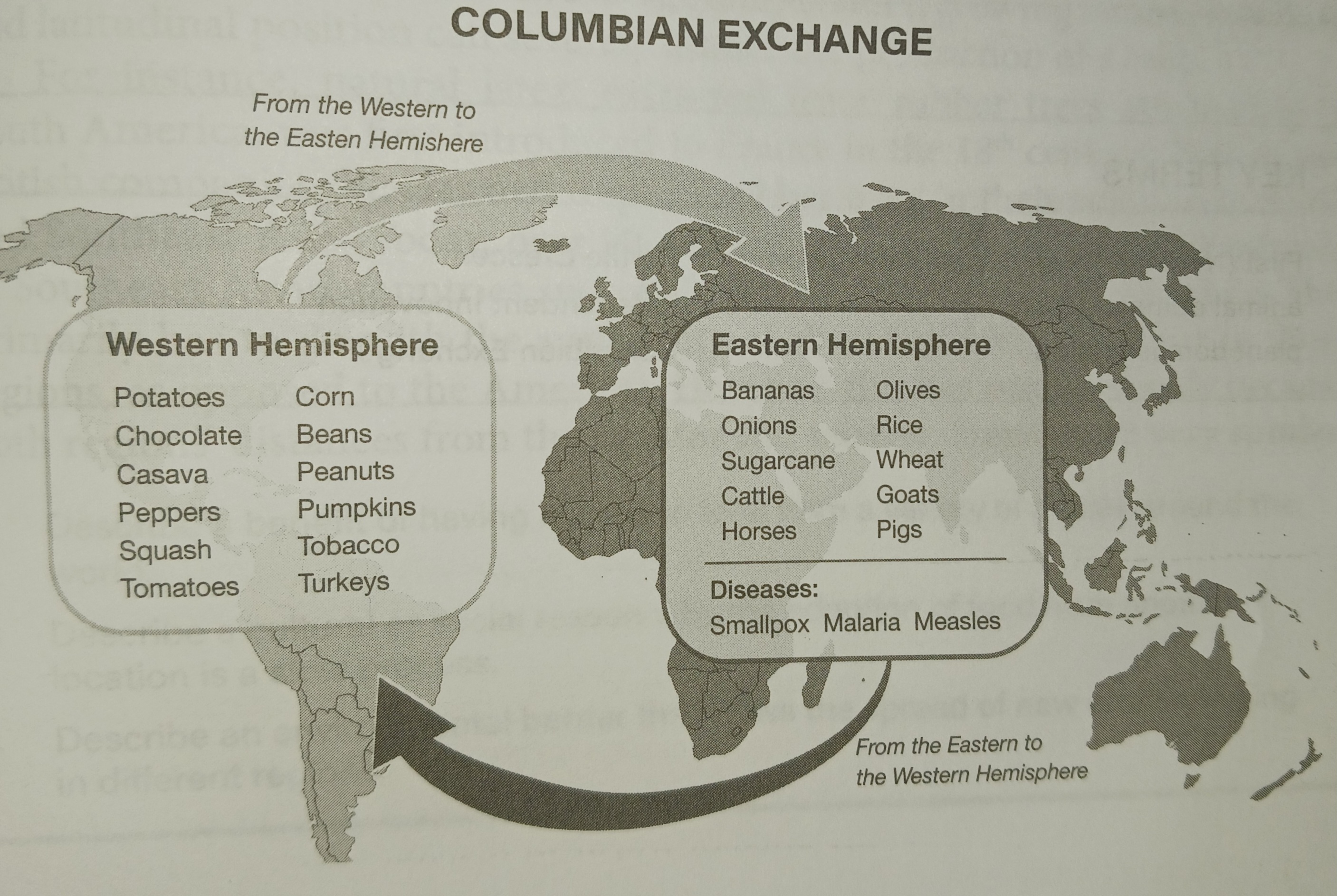
Commercial Agriculture
Large-scale farming operations employing mechanization, large land bases, and advanced technology.
Commodity Chain
Links connecting production and distribution places, leading to commodities being exchanged on the world market.
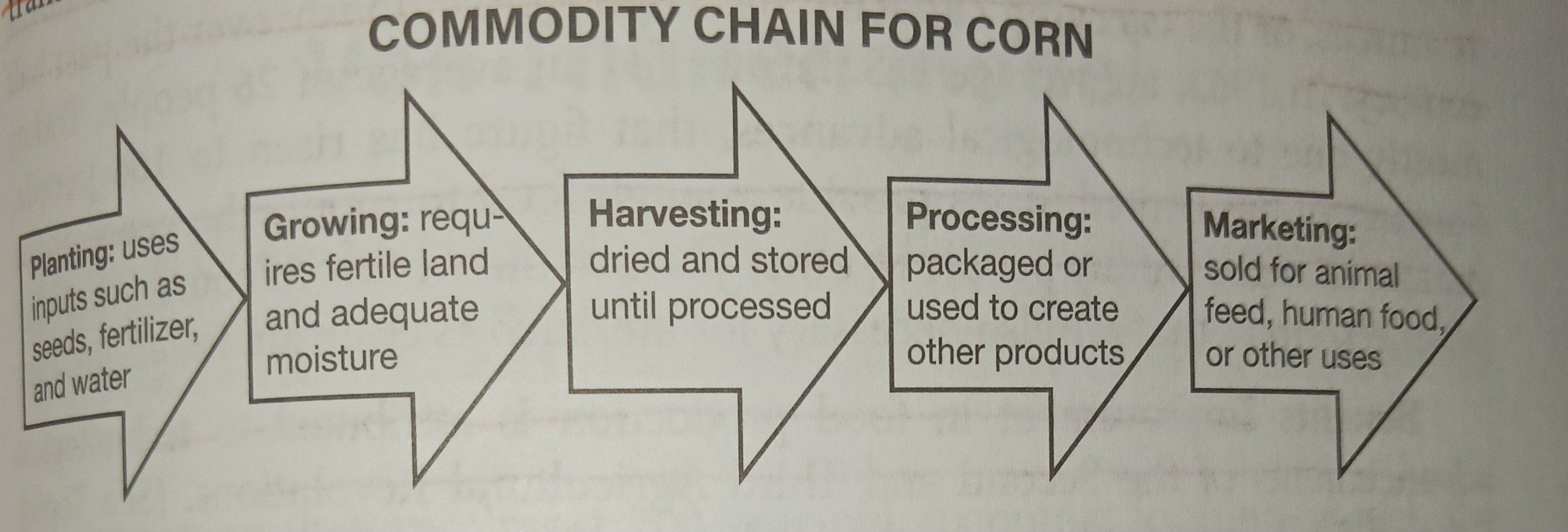
Community-Supported Agriculture
Connects producers and consumers, allowing consumers to subscribe to a farm's harvest.
Conservation
Preservation and protection of natural resources to prevent exploitation or neglect.
Deforestation
Clearing or thinning of forests by human activities.
Desertification
Fertile land turns into desert due to drought, deforestation, or inappropriate agricultural practices.
Ex. Sahel desert
Domestication
Taming animals or cultivating plants for human use.
Economies of Scale
Cost advantages due to the scale of operation, leading to decreased cost per unit of output.
Extensive Agriculture
Production system using small inputs of labor, fertilizers, and capital relative to land area.
Ex: extensive cattle ranching in regions like the Australian Outback
Fair Trade
Trade between developed and developing countries ensuring fair prices for producers.
why is fairtrade important for developing countries
it ensures that producers receive fair prices for their goods, providing stability and a sustainable income. This practice promotes social equity by advocating for ethical labor standards, including fair wages and safe working conditions, leading to improved living standards for workers. Additionally, fair trade encourages sustainable farming practices, contributing to environmental conservation and the long-term viability of agriculture in developing regions. The initiative also supports community development through the allocation of premiums for projects such as education, healthcare, and infrastructure, fostering overall well-being in marginalized communities.
Fertile Crescent
Fertile land in the Middle East around the Tigris and Euphrates rivers.
First Agricultural Revolution
Transformation from hunting and gathering to farming between 10,000 BC and 2000 BC.
Food Desert
Area with limited access to affordable and nutritious food.
Food Insecurity
Measure of food availability and individuals' access to it.
Genetically Modified Organisms (GMOs)
Organisms with altered genetic material using genetic engineering.
pros and cons of GMO’s
Pros:
1. Increased Crop Yield: GMOs are often engineered to be more resistant to pests, diseases, and environmental stresses, leading to higher crop yields. This can help address food security issues by producing more food on less land.
2. Enhanced Nutritional Content: Genetic modification can be used to enhance the nutritional content of crops, such as increasing levels of vitamins, minerals, and other beneficial compounds, potentially improving public health outcomes.
3. Reduced Need for Chemical Pesticides: Some GMOs are designed to be resistant to pests or herbicides, reducing the need for chemical pesticides and herbicides. This can lead to lower environmental impact and decreased exposure to harmful chemicals for farmers and consumers.
Cons:
1. Environmental Concerns: There are concerns about the potential environmental impacts of GMOs, such as unintended harm to non-target organisms, gene flow to wild populations, and disruption of ecosystems.
2. Health Risks: Some people are concerned about the potential health risks associated with consuming GMOs, although scientific consensus generally holds that GMOs currently on the market are safe to eat. However, long-term health effects are still being studied.
3. Corporate Control: Critics argue that GMOs are often developed and patented by large corporations, leading to concerns about corporate control over the food supply, farmer dependence on patented seeds, and lack of transparency in the regulatory process.
Global Supply Chain
Worldwide network involving people, information, processes, and resources in production and distribution.
Green Revolution
Increase in crop production through fertilizers, pesticides, and high-yield crop varieties.
This was part of the third Agricultural Revolution
The impacts of the green revolution
Pros:
Global food production increased dramatically after the introduction of new seed technology mechanization pesticides chemicals that are human-made fertilizers and irrigation led to increased yields more food led to reduced hunger lower death rates and growing populations in many parts of the developing world.
Cons:
while crop yields increase they often do so at the expense of the natural environment and this is because of manufactured products such as piracies chemical fertilizers pesticides and fossil fuel-using equipment. This caused soil decoration and also the Green Revolution did not help in Africa because of the greater diversity of climate and animals and plants
Intensive Agriculture
a farming method where a high level of inputs, such as labor, machinery, fertilizers, and pesticides, is used on a relatively small area of land to maximize the yield of crops or livestock.
Ex: poultry, market farming
Irrigation
Application of controlled water amounts to plants for crop growth and landscape maintenance.
How was the Aral Sea impacted by irrigation?
The Aral Sea's dramatic shrinkage resulted from extensive irrigation projects initiated during the Soviet era, diverting water from its main tributaries for large-scale cotton and rice cultivation.
Local-Food Movement
aim to connect food producers and consumers in the same geographic region, to develop more self-reliant and resilient food networks; to improve local economies; or to affect the health, environment, community, or society of a particular place.
Long Lots
Regional land surveying approach dividing land into narrow parcels stretching back from rivers, roads, and canals. (French)
pros and cons for long lots
Pros:
1. Equal Access to Resources: Long lots provide relatively equal access to resources such as water, sunlight, and transportation routes for each landowner since each lot has frontage along a road or waterway.
2. Maximized Land Use: The long, narrow shape of the lots allows for efficient use of available land, as it facilitates access to transportation and irrigation while minimizing the amount of land wasted on non-productive areas.
3. Preservation of Agricultural Land: Long lots are well-suited for agricultural use, as they allow for the efficient use of machinery and irrigation systems. This can help preserve agricultural land and promote sustainable farming practices.
4. Scenic Views: In some cases, long lots situated along waterways or scenic roads can offer picturesque views for landowners, enhancing the aesthetic value of the property.
Cons:
1. Limited Frontage: The narrow width of long lots may limit access to the property from the road, potentially creating logistical challenges for landowners, especially for larger machinery or equipment.
2. Fragmented Ownership: Long lots can result in fragmented ownership patterns, with numerous landowners holding small, irregularly shaped parcels. This fragmentation can complicate land management and development.
3. Potential for Land Conflicts: The elongated shape of long lots can lead to conflicts over access rights, boundary disputes, and restrictions on land use. Resolving these conflicts may require legal intervention and can strain relationships between neighboring landowners.
4. Limited Flexibility: Long lots may not be suitable for all types of development or land uses. Their narrow shape may limit options for building placement, subdivision, or expansion, restricting flexibility in land development.
Market Gardening
Small-scale production of fruits, vegetables, and flowers as cash crops, often sold directly.
Mechanized Farming
Use of agricultural machinery to increase farm worker productivity.
Mediterranean Agriculture
Significant production of olive oil, wine, grape, dried nut, and citrus
Metes and Bounds
British land surveying system using land ownership descriptions and natural features.
pros and cons of metes and bounds
Pros:
1. Flexibility: Metes and bounds allow for flexibility in defining property boundaries, as they describe land parcels using physical features like landmarks, distances, and directions. This flexibility can be useful in irregularly shaped parcels or areas with diverse terrain.
2. Detailed Descriptions: The system provides detailed descriptions of land parcels, including precise measurements and natural landmarks, which can help minimize disputes over property boundaries.
3. Historical Significance: Metes and bounds have historical significance, as it has been used for centuries in many regions. It is often deeply ingrained in local property law and traditions.
Cons:
1. Complexity: Metes and bounds can be complex and difficult to interpret, especially for individuals without specialized knowledge in land surveying or legal terminology. This complexity can lead to confusion, errors, and disputes over property boundaries.
2. Subjectivity: Descriptions in metes and bounds rely on subjective interpretations of physical features and directions, which can vary depending on the surveyor or individual interpreting the description. This subjectivity can lead to inconsistencies and disagreements.
3. Limited Applicability: Metes and bounds may not be well-suited for large-scale land surveys or areas with uniform, grid-like layouts. In such cases, other surveying methods, such as the rectangular survey system, may be more practical and efficient.
Mixed Crop/Livestock System
Production of animals and crops on the same farm, utilizing waste as fertilizer.
Monocropping/Monoculture
Growing a single crop year after year on the same land.
Ex. Corn, soybeans, and wheat
Nomadic Pastoralism
Herding livestock to find fresh pastures with irregular movement patterns.
Plantation Agriculture
Commercial farming of crops for profit, requiring large land areas and tropical climates.
Ranching
Running a large farm, especially for raising cattle, horses, or sheep.
Second Agricultural Revolution
Introduction of new crop rotation techniques and selective breeding of livestock.
Describe the main impacts of the 2nd Agricultural Revolution on world populations.
Innovations such as iron plows, crop rotation, and the introduction of new crops increased agricultural productivity, leading to population growth and improved food security. Urbanization surged as surplus labor from farms moved to burgeoning cities in search of employment opportunities. Technological advancements, changes in land ownership, and the global exchange of crops marked profound shifts in agricultural practices, setting the stage for further economic and social transformations.
Shifting Cultivation
Cultivating land temporarily, then abandoning it to revert to natural vegetation.
Ex: slash-and-burn
Slash and Burn Agriculture
Growing food by clear-cutting and burning forested land for nutrient-rich soil.
Soil Salinization
Land degradation decreasing soil fertility; competent to desertification, often due to inappropriate irrigation.
Subsistence Agriculture
Farmers growing food crops to meet family needs with little or no surplus for trade.
Sustainability
Focus on meeting present needs without compromising future generations' ability to meet their needs. The concept of sustainability is composed of three pillars: economic, environmental, and social—also known informally as profits, planet, and people.
Terrace Farming
Farming on man-made terraces built into slopes.
What is the environmental impact of terrace farming?
The environmental impact of terrace farming is generally positive, contributing to soil conservation, efficient water management, and alterations in microclimates. However, challenges include labor-intensive construction, potential impacts on local biodiversity, and the displacement of excess water downslope, highlighting the importance of careful management to maximize the benefits of this sustainable farming method.
Township and Range
Land surveying system with townships divided into 36 sections arranged in a 6 by 6 system, measuring 6 miles by 6 miles. and ranges assigned east or west of a Principal Meridian.
Origin: USA
Pros and cons of Township and range
Pros:
1. Orderly Land Division: The township and range system provides a systematic way to divide and organize large land areas, particularly in the United States. This makes it easier to manage and administer land for various purposes, such as agriculture, settlement, and resource extraction.
2. Ease of Legal Description: The system allows for straightforward legal descriptions of land parcels, which is useful for property ownership records, land surveys, and real estate transactions.
3. Facilitates Resource Management: By dividing land into square units, the system facilitates the management of natural resources, such as minerals, timber, and water, by delineating ownership boundaries and administrative jurisdictions.
Cons:
1. Inflexibility: The township and range system can be rigid and inflexible, especially in areas where natural features or historical patterns of land use do not conform to the grid-based layout. This can lead to inefficiencies and complications in land management and development.
2. Limited Adaptability: The system may not be suitable for all geographic regions or land uses, particularly in areas with irregular terrain, dense vegetation, or complex ownership arrangements. In such cases, alternative land division methods may be more practical and effective.
3. Lack of Community Planning: The grid-based layout of the township and range system often lacks consideration for community planning and design principles, such as walkability, mixed land uses, and green spaces. This can result in suburban sprawl, traffic congestion, and environmental degradation in urban and suburban areas.
Transhumance
Seasonal movement of pastoralists and livestock between highland and lowland pastures.
The environmental impact of transhumance
grazing management and ecosystem characteristics. Potential consequences include overgrazing leading to soil erosion, reduced vegetation cover, and impacts on local biodiversity if not managed sustainably.
Urban Farming:
The practice of cultivating, processing, and distributing food in or around urban areas.
Ex: husbandry, aquaculture, agroforestry, urban beekeeping, and horticulture.
Value-Added Specialty Crops
The process of changing the physical state or form of a product, such as milling wheat into flour or making strawberries into jam.
Von Thünen’s model
a theoretical framework that explains the spatial arrangement of agricultural land use around a central market or urban area. According to the model, different types of agricultural activities are organized in concentric rings or zones around the market center based on their transportation costs and land rent. The model suggests that intensive, perishable crops are located close to the market center, while extensive, less perishable crops and livestock production are located further away.
Creator: Johann Heinrich von Thünen
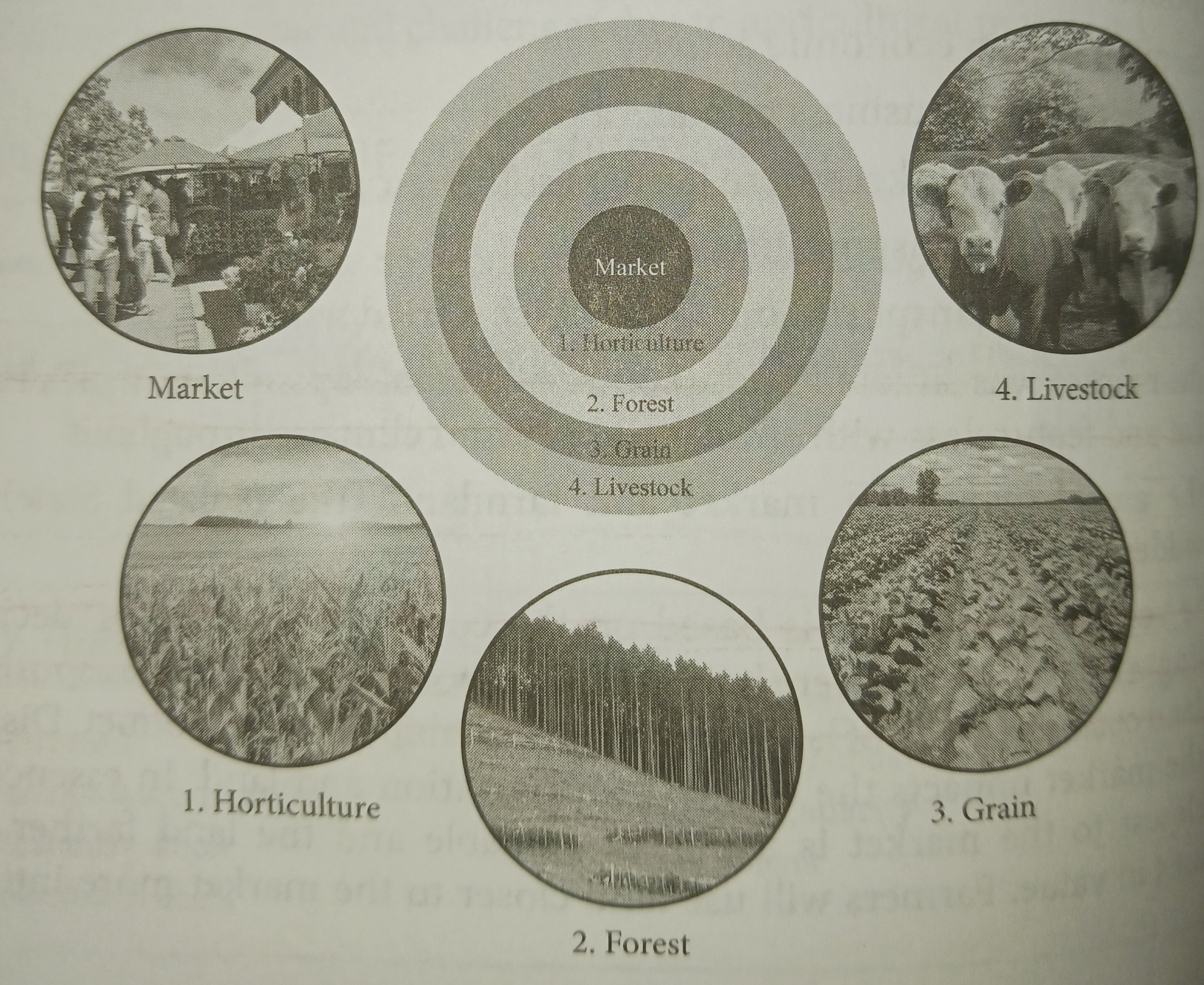
pros and cons of the Von Thünen’s model
Pros
1. Simplicity: The model provides a simple and systematic framework for understanding the spatial organization of agricultural activities around a central market or urban area.
2. Predictive Power: It helps in predicting the spatial distribution of different types of agricultural activities based on transportation costs and land rent, which can be valuable for land use planning and management.
3. Historical Insight: The model offers historical insights into past agricultural practices and land use patterns, particularly in pre-industrial societies.
Cons
1. Simplistic Assumptions: The model relies on several simplifying assumptions, such as uniform flat terrain, equal access to the market, and homogeneous site characteristics, which may not accurately represent real-world conditions.
2. Limited Applicability: The model may not fully account for the complexities of modern agricultural systems, including technological advancements, globalization, trade, and shifts in consumer preferences.
3. Changes Over Time: The model's predictions may not hold true in contemporary times due to changes in transportation technology, land use policies, agricultural practices, and global market dynamics.
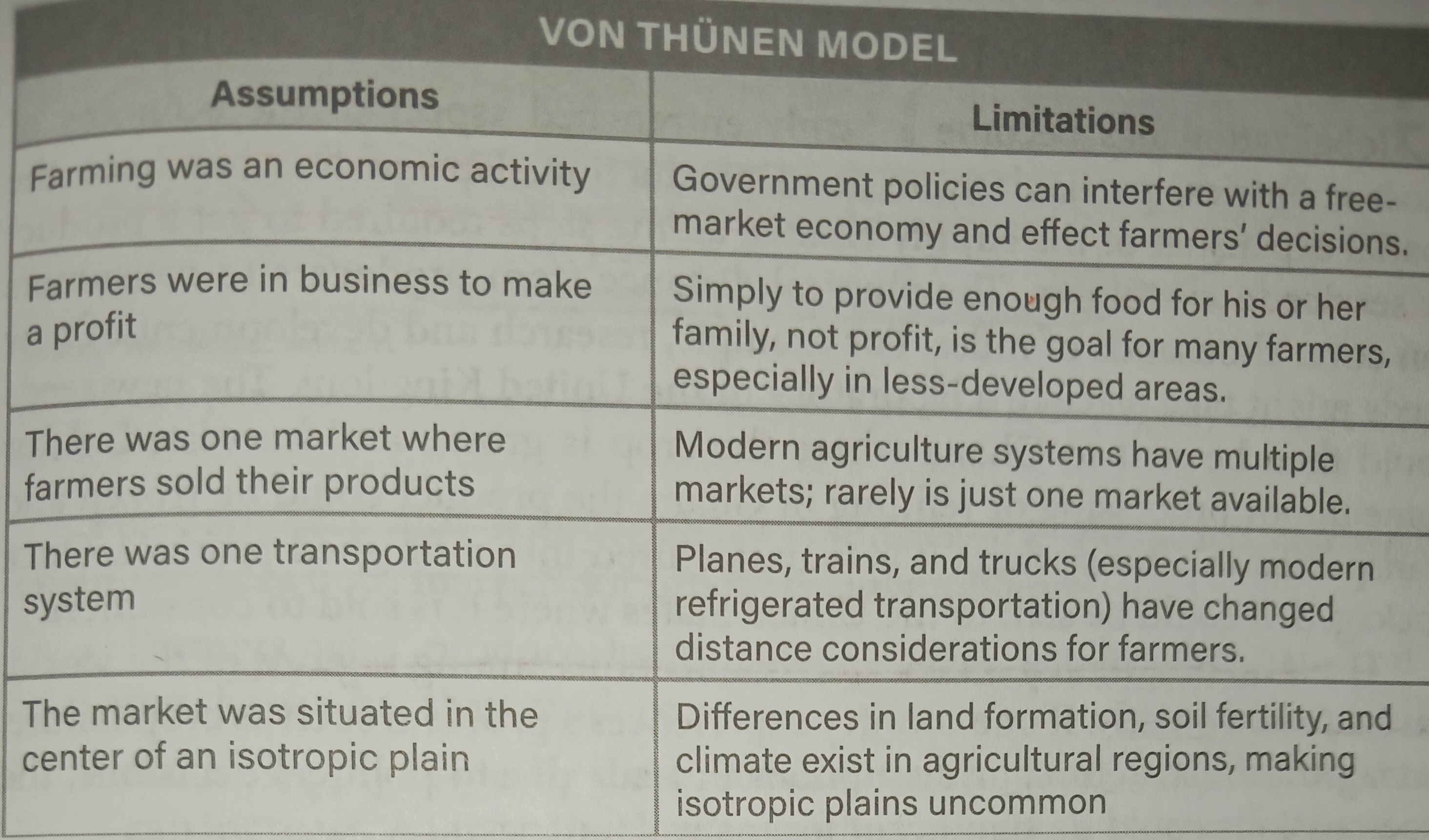
Cultural hearth
where a religion or ethnicity began
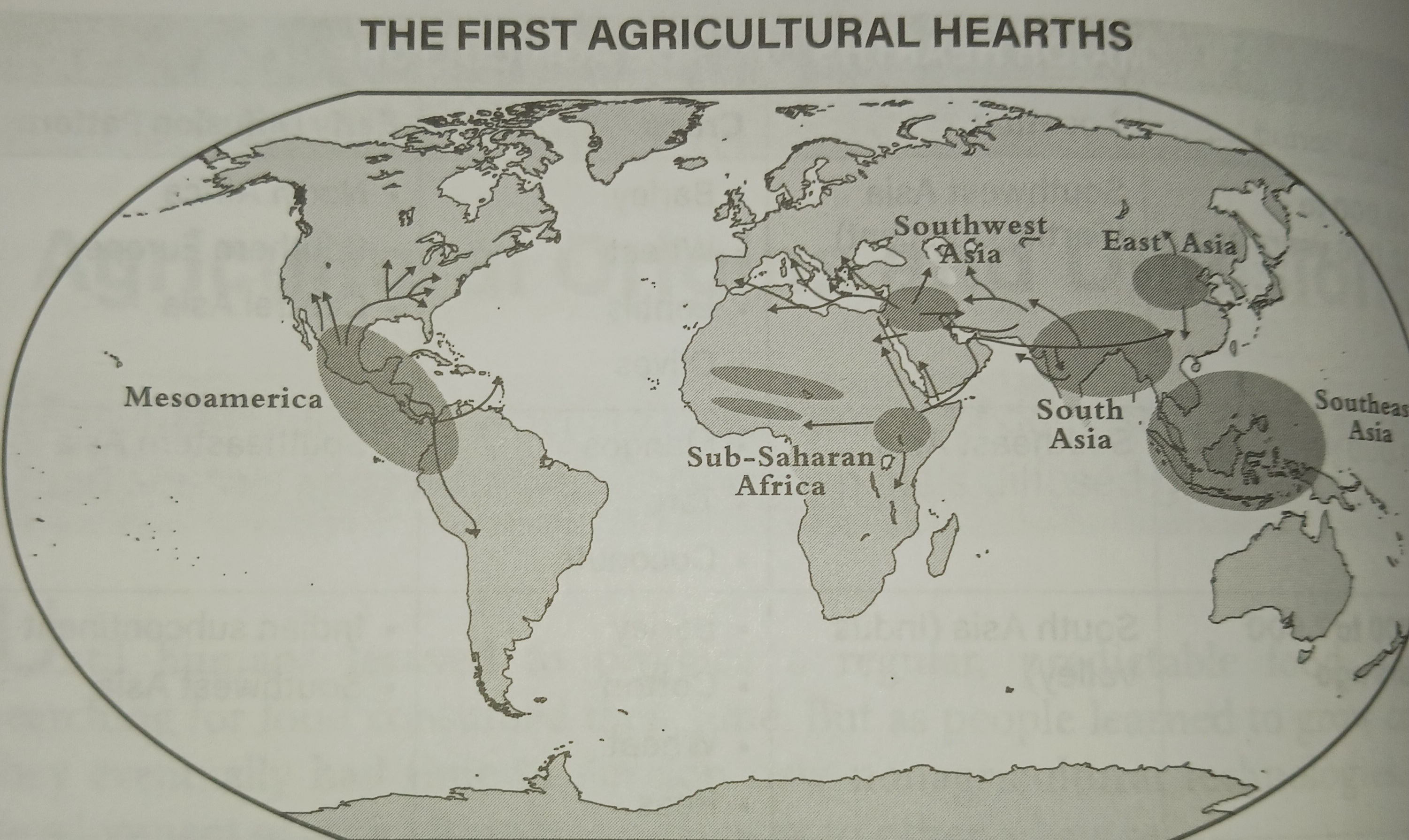
Examples of cultural hearths
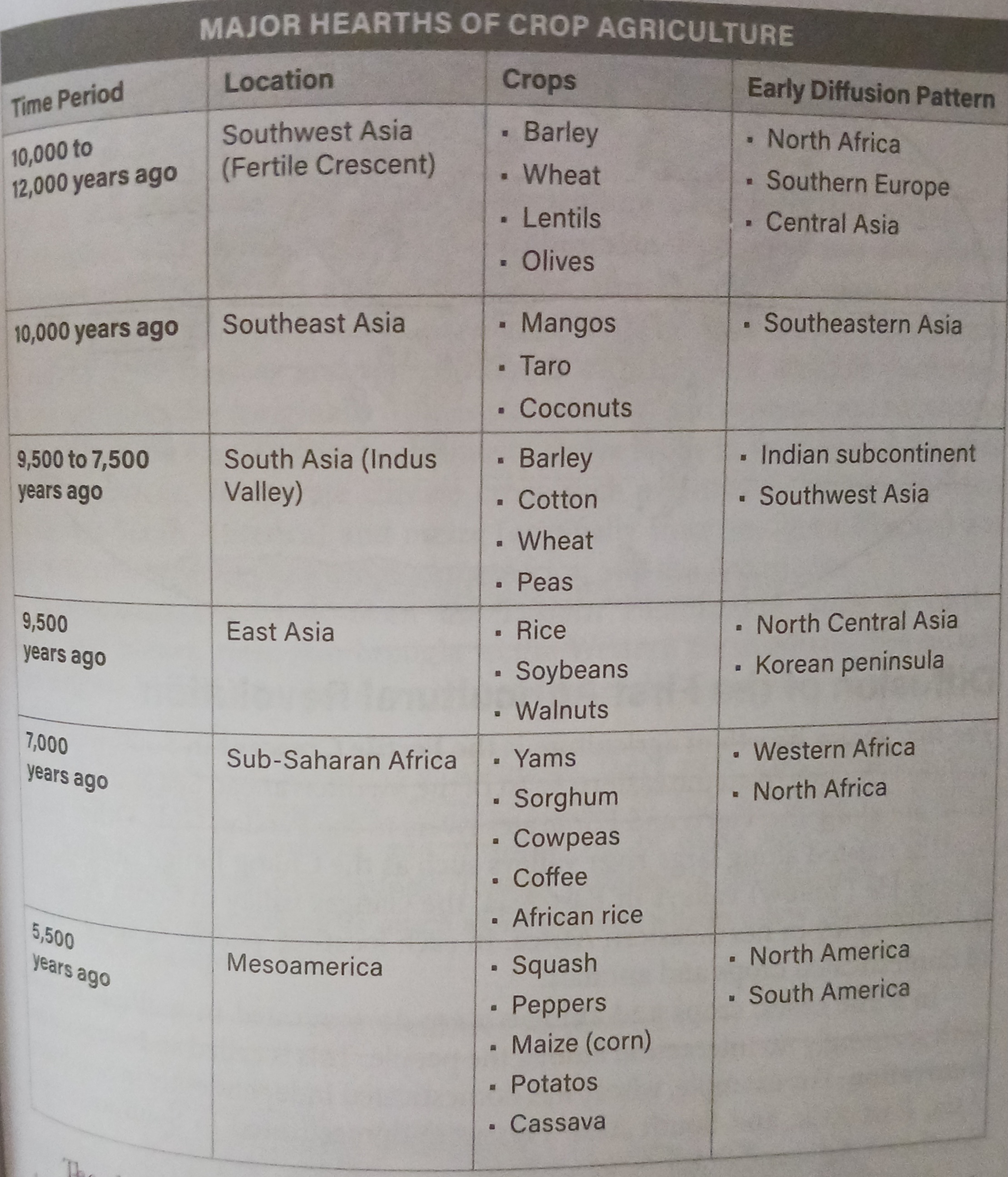
agriculture regions
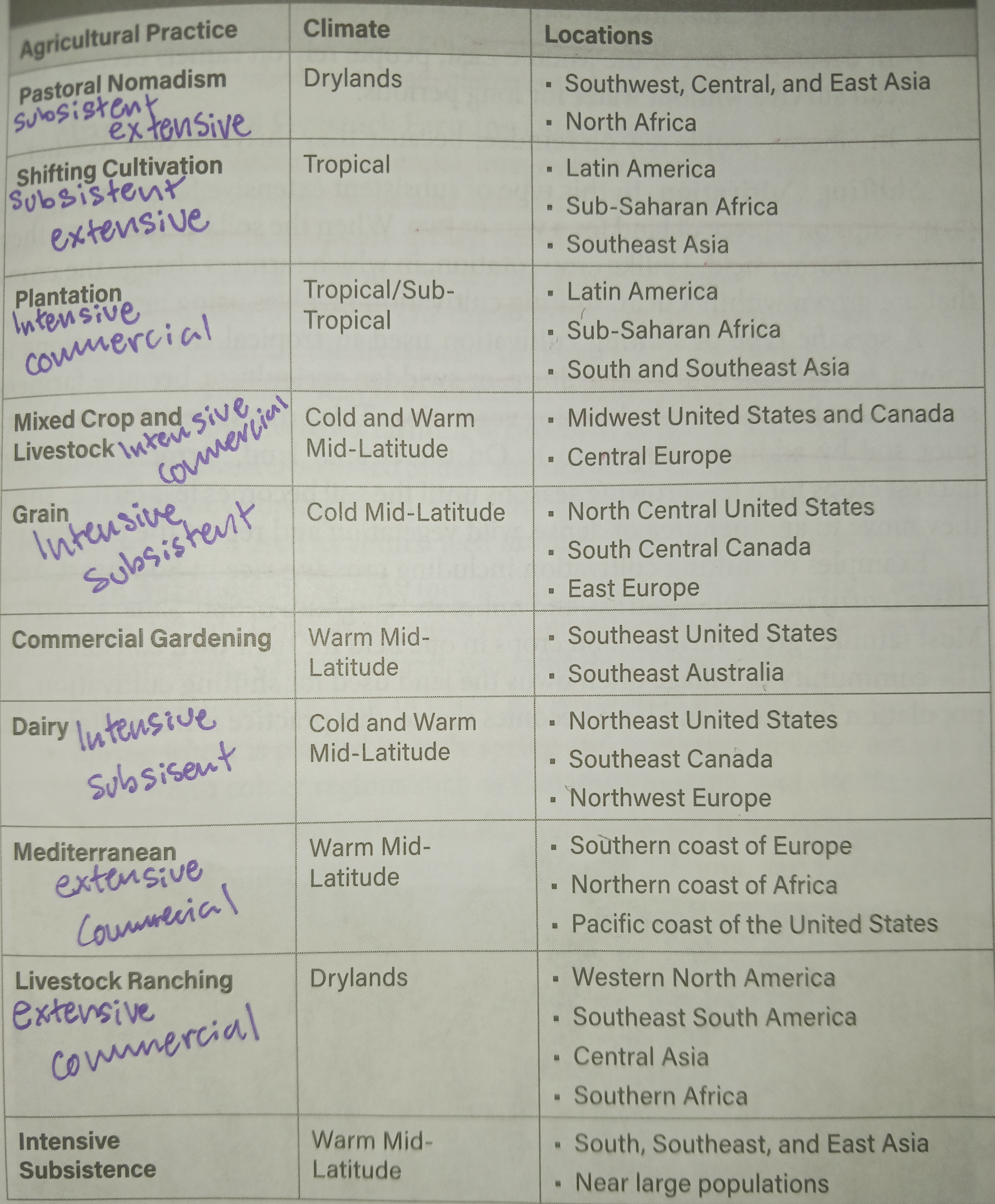
Types of agriculture
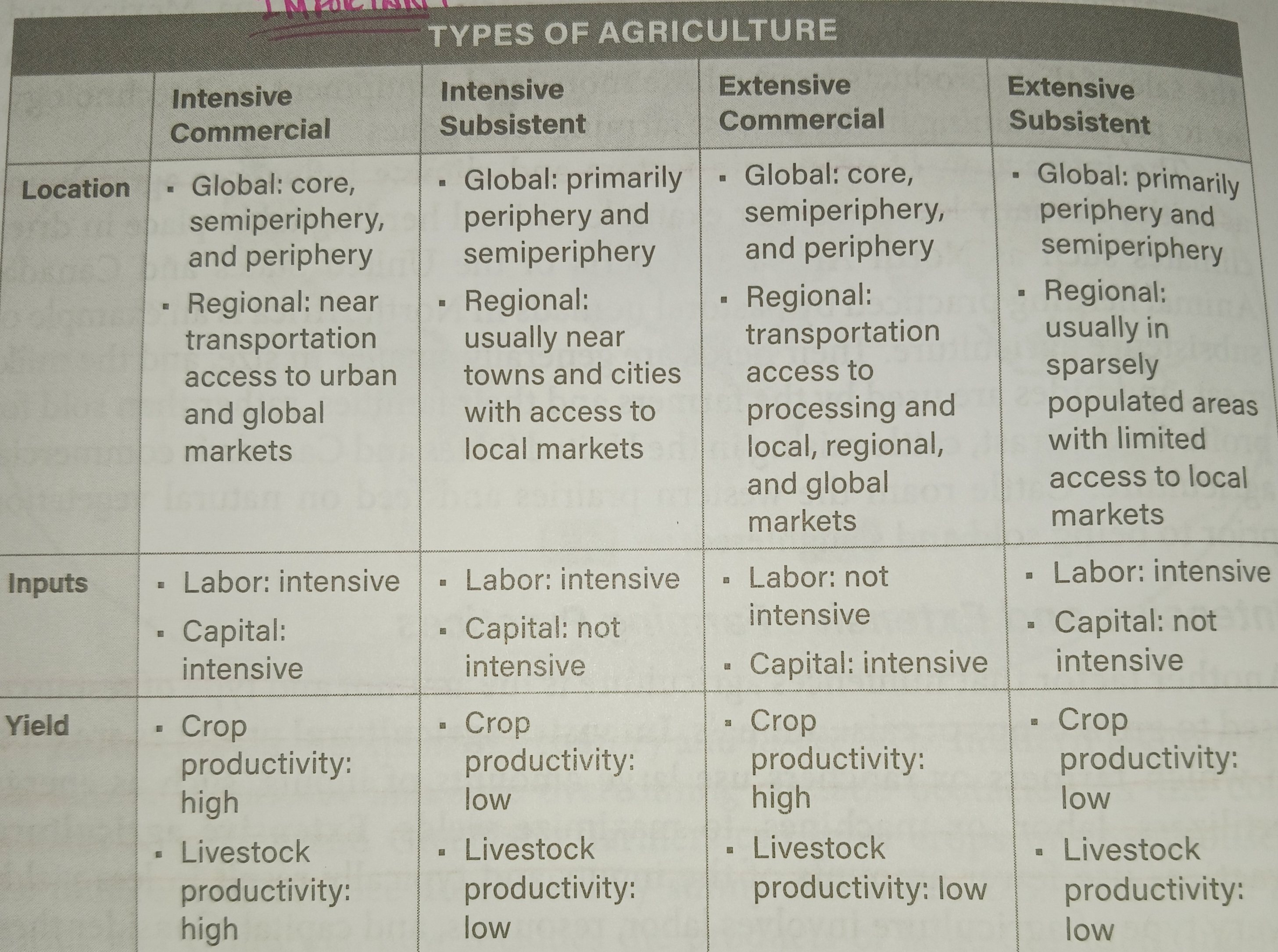
Capital
The money invested in land equipment and machines
Intensive commercial agriculture
Examples include Market gardening plantations and large-scale mixed crop and Livestock systems
Intensive substance agriculture
An example is rice patties in Southeast Asia
Extensive commercial gardening
An example is ranching
Extensive substance agriculture
Examples include nomadic herding and shifting cultivation
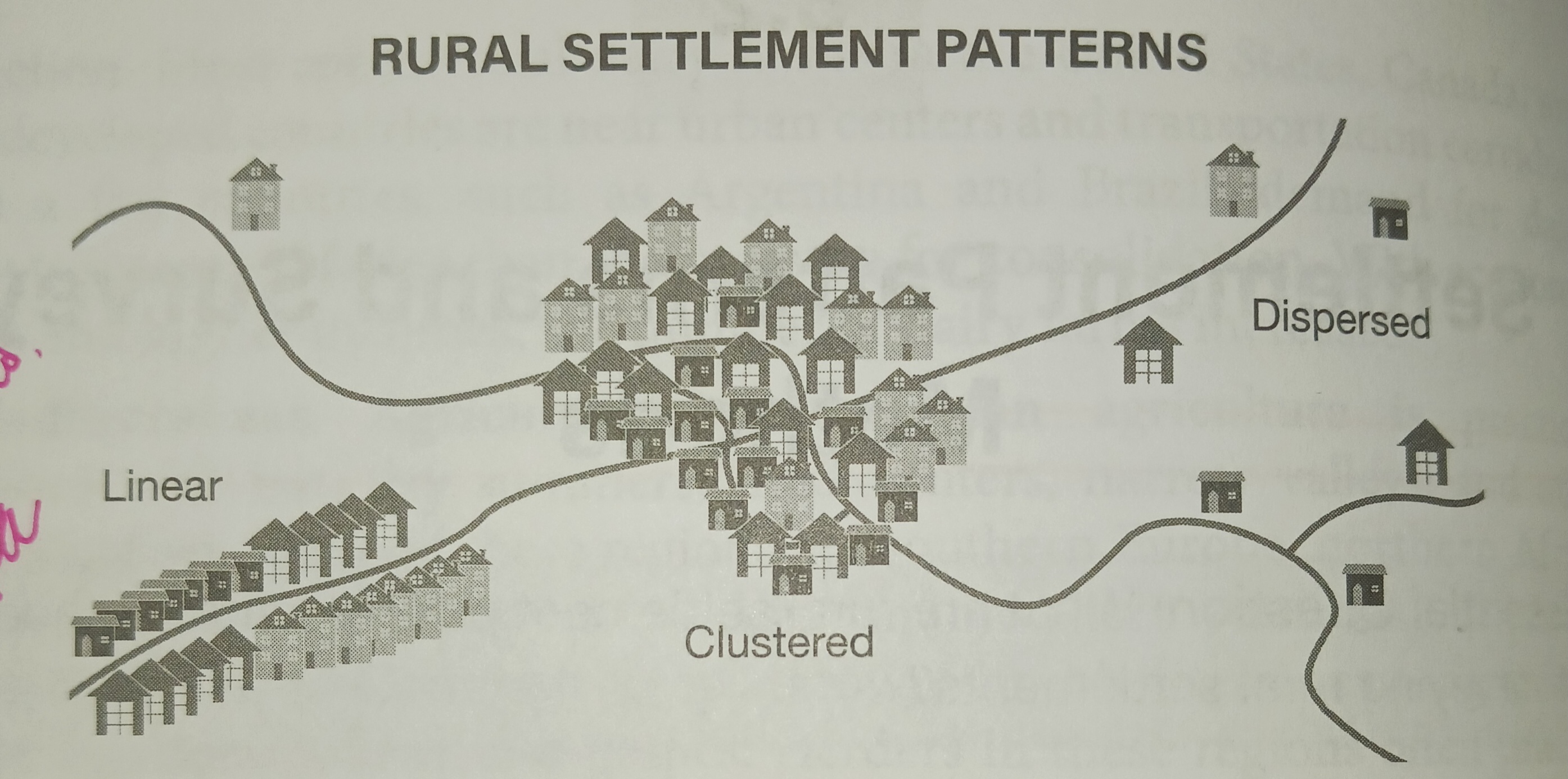
Clustered/ nucleated settlements
Groups of Homes located near each other in a village and fostered a strong sense of place and often shared of services such as schools
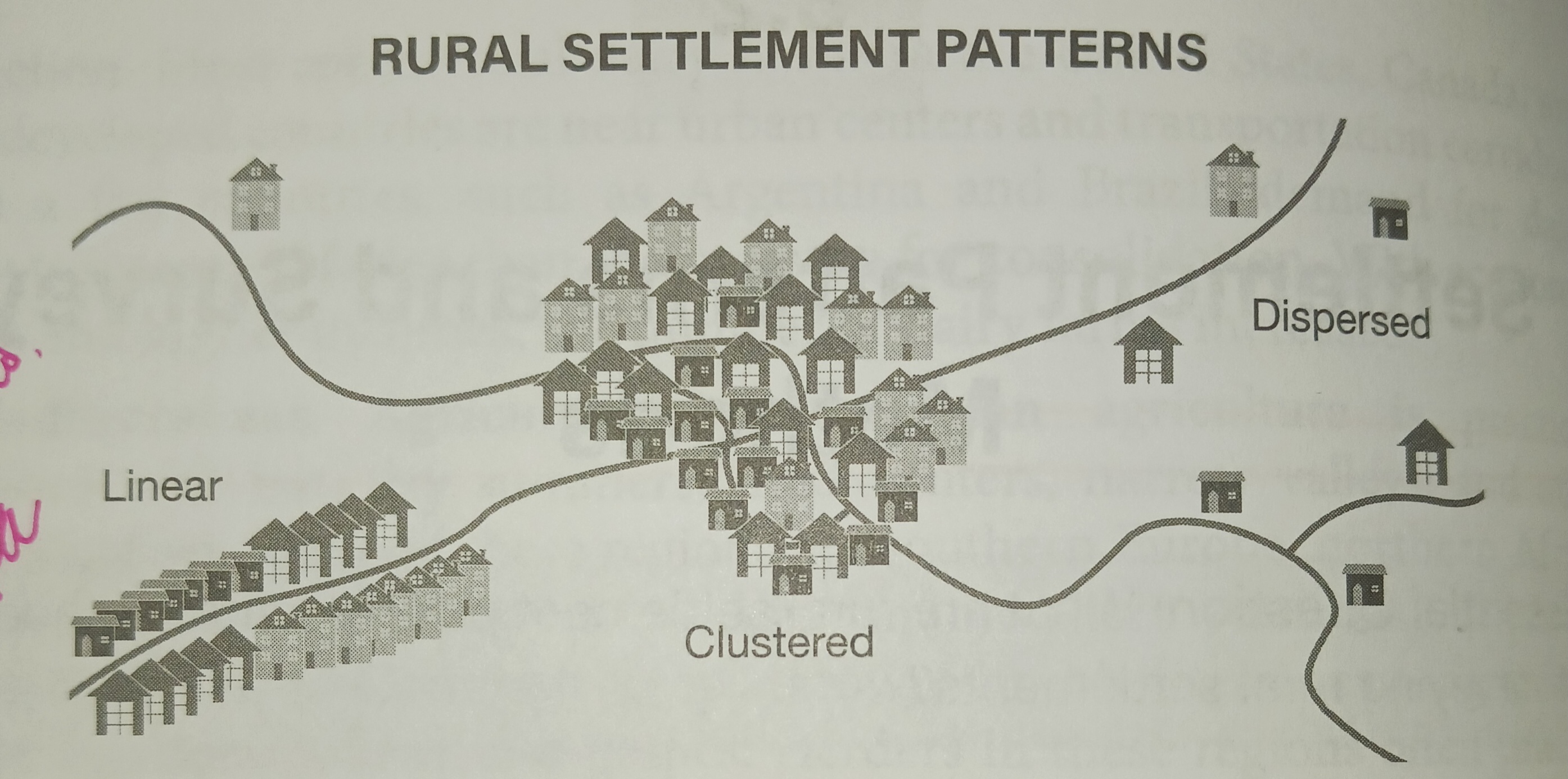
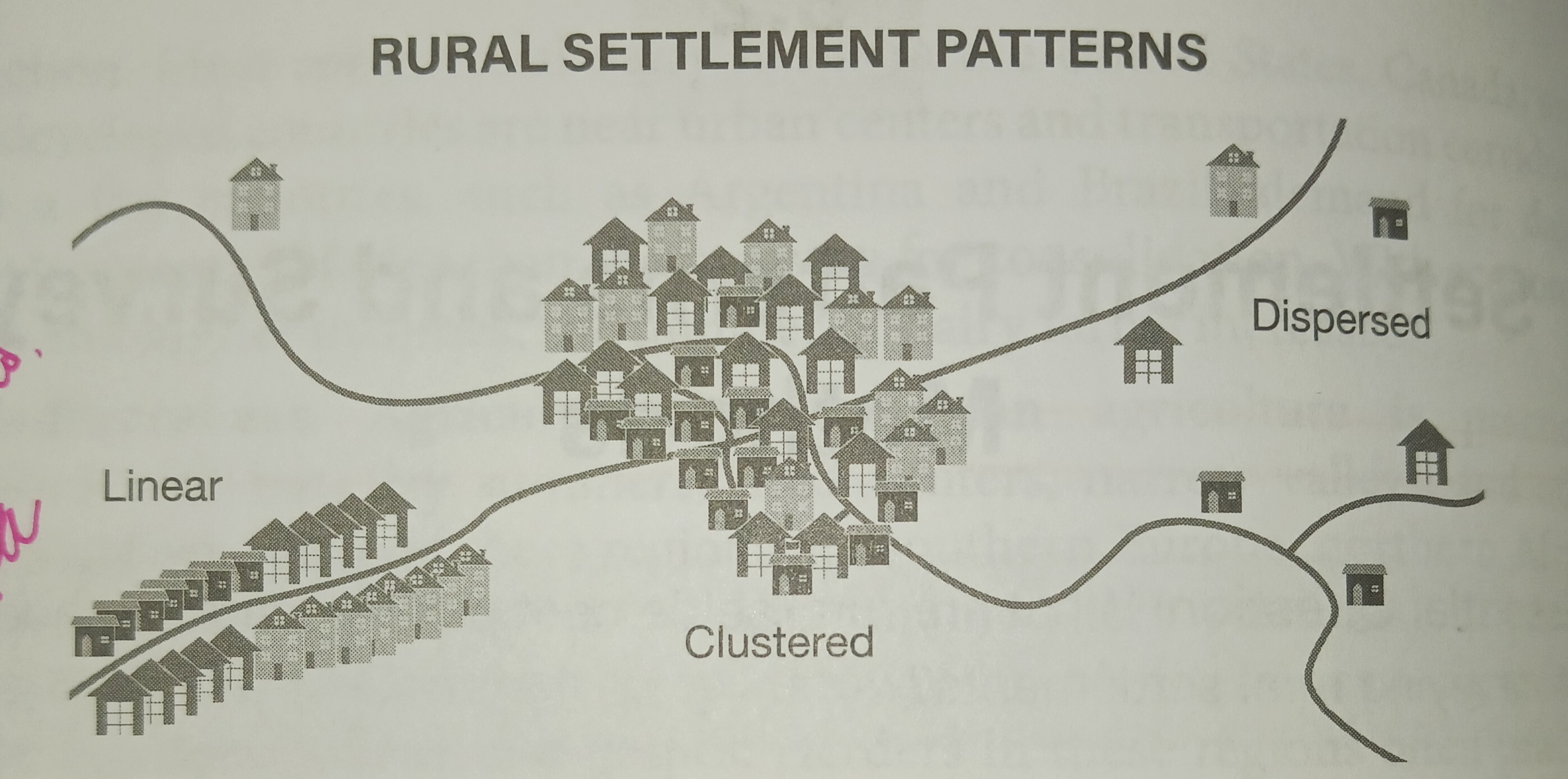
Dispersed settlement
Patterns in which Farmers lived in home spread throughout the countryside
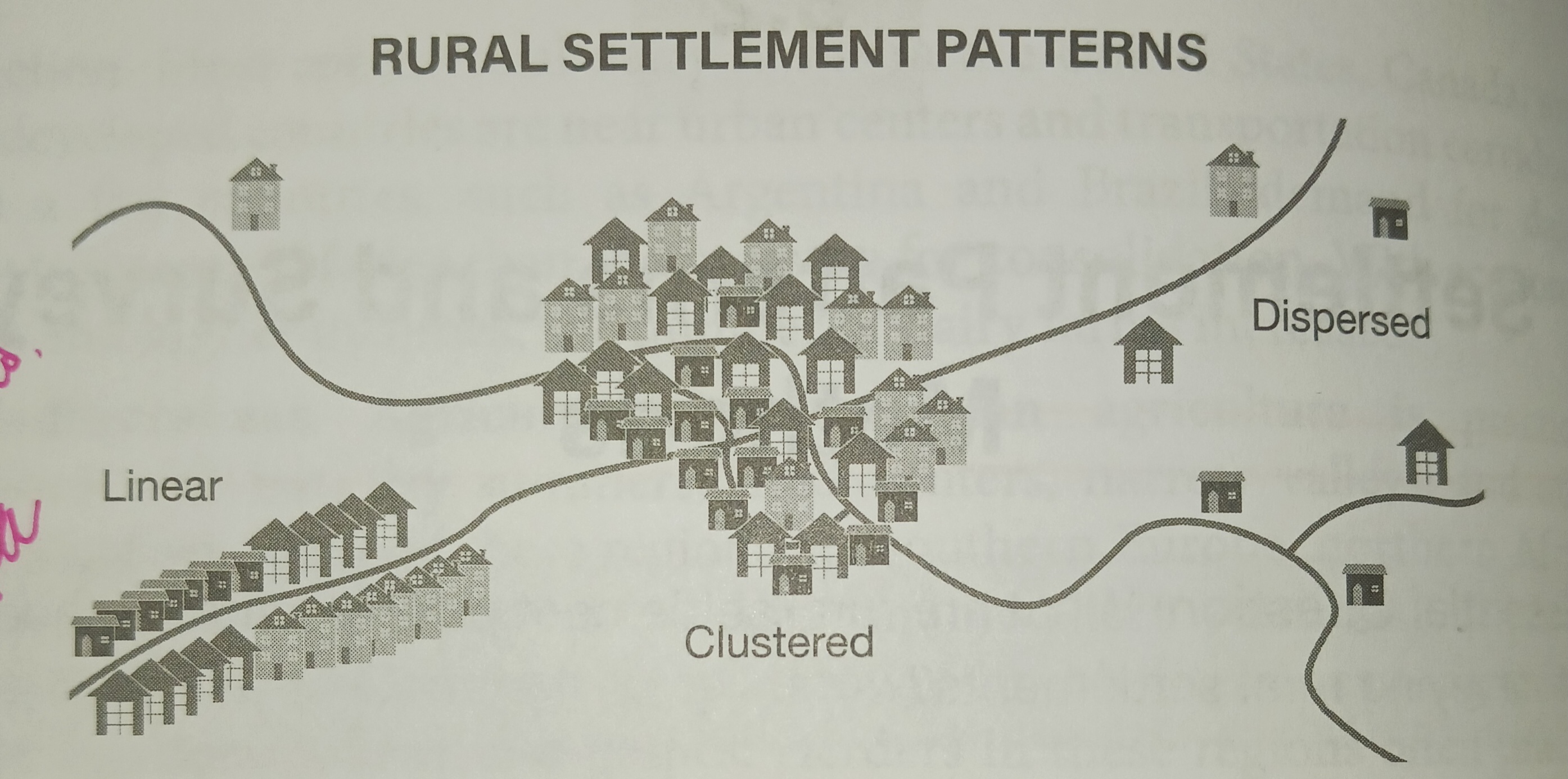
Linear settlement
Buildings and human activities are organized close to a body of water or along a transportation route making a straight line
What's another name for township and range
Public land survey system
Where did the first article Revolution start
It started in the hearths located in Southwest Asia, East Asia, South Asia, Africa, and the Americas
Independent innovation
Crops and animals were domesticated and multiple regions with seemingly no interaction among the people
Enclosure Acts
A series of laws and acted by the British government that enabled land owners to purchase and enclosed land for their own use
Early advancements in modern agriculture
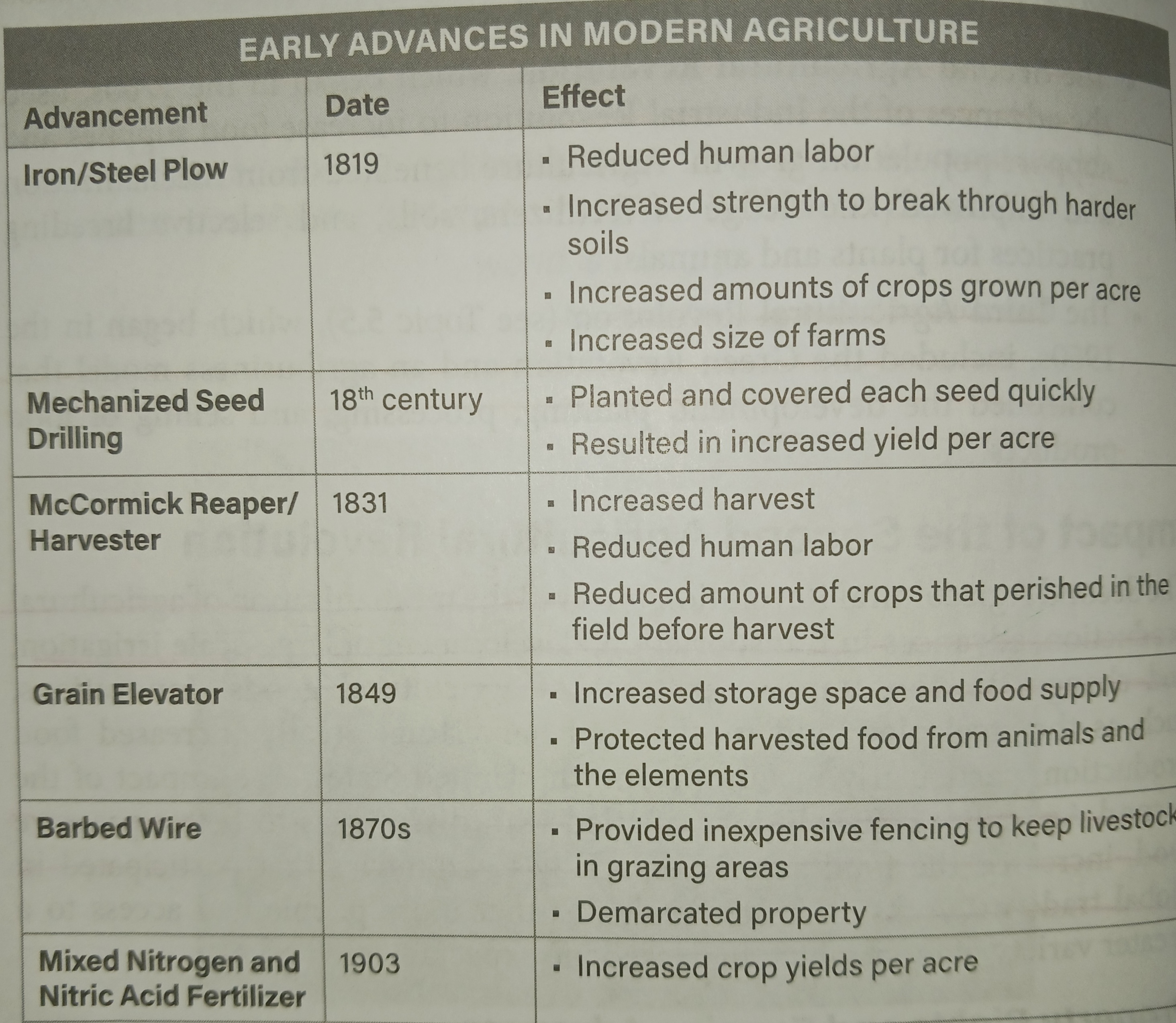
The third Agricultural Revolution
science research and technology and it continues today this revolution expanded mechanization of farming developed new Global agricultural systems and use scientific and information Technologies to further previous advances in agricultural products
Hybridization
The process of breeding two plants that have desirable characteristics to produce a single seed with both characteristics
horizontal integration
occurs when a company acquires or merges with another company in the same industry that is operating at the same level in the value chain. Companies may pursue horizontal integration to grow their existing business or prevent a competitor from gaining market share.
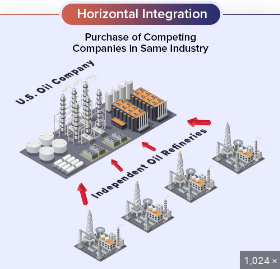
Vertical integration
the business arrangement in which a company controls different stages along the supply chain. Instead of relying on external suppliers, the company strives to bring processes in-house to have better control over the production process.
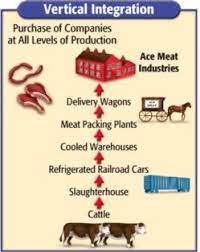
Cool chains
Transportation networks that keep food cool throughout a trip
Isotropic plane
Flat and featureless with similar fertility and climate throughout
Horticulture
A type of Agriculture that includes Market gardening truck farming and dairy farming would occur
Bid rent curve
Used to determine the starting position for each land use relative to the market as well as where each land would be end
Free market economy
We're supply and demand not government policy determine the outcome of competition for land the farmer who will have the greatest profit will pay the most at each location to occupy the land
Comparative advantage
Naturally occurring beneficial conditions that would prompt Farmers to plant crops differently from those predicted by von thünen model
Supply chains
Steps required to get product or service to customers
Luxury crops
Not essential to human survival but have a high profit margin
Ex. Cocoa beans
Subsidies
Public financial support to Farmers to safeguard food production from governments across the world
Center pivot irrigation
Watering equipment rotates around a pivot and deliver specific amounts of water fertilizer or pesticides to the field/ the circle irrigation pattern in the township and range
Vertical Farms
They grow crops inside stackable trays using greenhouses artificial lights and Hydroponics
Hydroponics
Allows crops to grow without soil using mineral enriched Solutions
Food distribution system
A network of trade and transportation that give food from farms to Consumers
Tariff
Tax on Imports
Quota
Limit the quantity of a good imported
Agricultural land use in the USA
